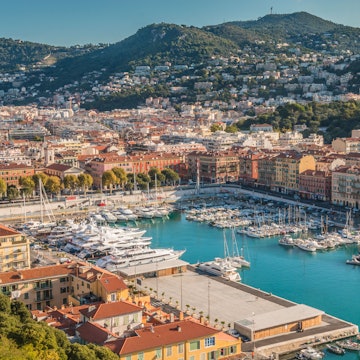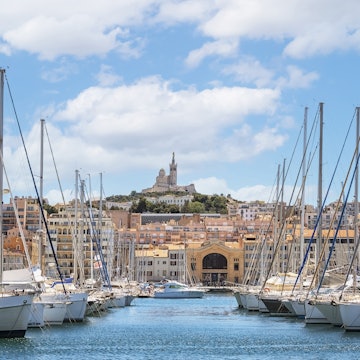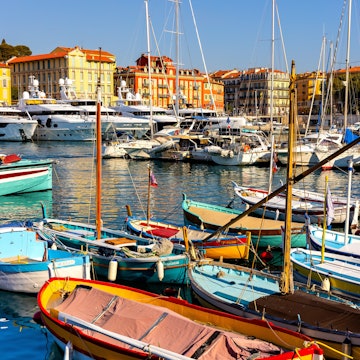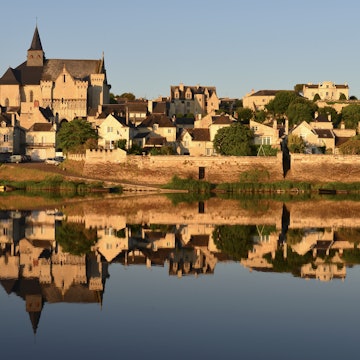

Arc de Triomphe in Montpellier. saiko3p/Shutterstock
Compared to most Mediterranean-facing French settlements, with their Roman ruins and long history, Montpellier is a fledgling city. It certainly feels youthful, with its creative energy and student-centered nightlife. But Montpellier is not young. Its origins lie in the 10th century and the Université de Montpellier, established by papal bull in 1289, has dictated the city’s youthful makeup since its founding. Its medical school is Europe’s oldest.
Now the capital of Languedoc-Roussillon, Montpellier is best known for its art and architecture. Although its hôtels particuliers (exquisite aristocratic mansions dotted around the city center) largely remain off-limits to visitors, Montpellier’s art museums showcase some of the finest collections in southern France.
Montpellier is a great place to dine out. With the Mediterranean on one side, rich farmland all around, and the mountains of Haut Languedoc on the other, an eclectic parade of ingredients march their way into the local cuisine. Hearty stews, delectable seafood and seasonal vegetables are all given that youthful makeover at a range of startups and inventive bistros. Evidently, the best way to experience Montpellier is via the senses.
Plan your visit with this guide to budget, transport and activities.

When should I go to Montpellier?
Spring, when the surrounding landscape is in full bloom, and early fall, when the grapes are being harvested, are the best times to visit Montpellier. Warm, calm weather is the norm during these months, without the cloying heat of summer or the chilly air of winter. Music lovers might want to consider a trip in late September, when the Internationales de la Guitare festival celebrates all guitar-inflected music through a series of shows and concerts.
Like much of lowland southern France, the summers can get extremely hot. During this time many French businesses shut up shop as everybody heads on vacation. Winter, outside of the Christmas season, is the best time to visit for budget-friendly hotel prices.
How much time should I spend in Montpellier?
A weekend in Montpellier would be sufficient to visit one or two museums and get a feel for its creative life and nightlife. However, to properly appreciate the city’s contrasting laidback side, give yourself 4 days, enjoy a leisurely lunch in a shaded square, explore the Jardin des Plantes and wander through the city’s own Arc de Triomphe.
If you’re looking for the perfect base from which to explore further afield, Montpellier’s transport connections make it a good choice for a longer stay. From here, you can take day trips to attractions in nearby towns such as the Roman ruins of Nîmes and the canals and oyster farms around Sète.

Is it easy to get in and around Montpellier?
Montpellier has a compact city center, much of which is pedestrianized or traffic-light. Additionally, there’s an extensive, four-route tram network, the Vélomagg bikeshare scheme and trains that connect Saint-Roch station, immediately south of the center, to cities throughout France and even Belgium.

Meet your new travel partner
Get unlimited data while you travel with Holafly eSIM. Peace of mind and no hidden fees wherever you go. Use code LONELYPLANET for an exclusive discount.
Direct flights link Montpellier airport to destinations in the UK, Italy, Denmark, the Netherlands, Algeria and Morocco, among other nations. The 620 bus goes from the airport to Place de l’Europe in central Montpellier.
Driving is the one area where Montpellier becomes tricky to get around, as city center parking is hard to come by. Parking garages, although often pricey for longer stays, are the best option.
For people with restricted mobility, Montpellier’s heavily pedestrianized core, wheelchair-friendly trams and disability-conscious infrastructure in most of the main museums and public spaces makes it an accessible city. Although the center isn’t flat, inclines are usually gentle.
Top things to do in Montpellier
With so many great things to do in Montpellier, it’s surprising to think that the city is largely overlooked by most visitors, who head instead for Marseille, Toulouse or Nice. As such, you’ll rarely find these attractions overcrowded. Here are just a few ideas to get you started.

Observe the brushstrokes of masters and outsiders
If you visit only one gallery during your trip to Montpellier, let it be the Musée Fabre. Founded in 1825, the collection walks visitors through the history of art between the 16th century and the present day. Encompassing over 40 rooms, it’s an exceptional accumulation of artworks by masters such as Pieter Paul Rubens, Gustave Courbet, Monet, Manet, Sonia Delaunay and Henri Matisse, among many others.
The Musée Fabre is merely an introduction to Montpellier’s artistic riches. The two MO.CO. galleries belong to the city’s MO.CO. school of fine arts. The main gallery, on rue de la République, produces provocative exhibitions from leading names in contemporary art, while the more central MO.CO. Panacée provides a canvas for local artists. Spare some time, if you can, for the overlooked Musée D'Arts Brut, where fascinating outsider art is displayed throughout the former home of artist Fernand Michel.
Linger in the public squares for a feel for local life
Experience the best of public life in France in its places. These large, often pedestrianized squares are particularly impressive in Montpellier and offer the a slice of the city’s everyday life. Montpellier’s main square is place de la Comedie, punctuated by its central fountain featuring the three Graces: youth, humor and elegance. Due to the place’s oval shape, it’s known to locals as "l’Oeuf" (the egg). Cafes line the square, as they do with virtually all the city’s places.
The exception is place Royale du Peyrou, which faces Montpellier’s own Arc de Triomphe. Pass through the 52m-high arch to reach a tree-lined square frequented by locals walking their dogs or playing games of pétanque. On the opposite side of the park to the Arc is the Château d’Eau, a water tower connected to the 18th-century St-Clémont Aqueduct. Nearby is the 16th-century Jardin des Plantes, France’s oldest botanical garden.

See chapters of the past through architecture
Remnants of the city’s creative legacy can be witnessed in buildings that have survived its thousand years of history. The hôtels particuliers are the most revered. These ornate townhouses were built between the late medieval period and 19th century by wealthy merchants and nobles. Hôtel de Varennes is one of the few open to visitors, albeit only the entrance hall and courtyard, with its ribbed vaulted ceilings. Elsewhere, La Tour de la Babote is one of the few vestiges of the city’s original 12th-century fortifications. And the evolution of design continues through modern buildings, such as the white, pineapple-shaped L'arbre Blanc by Sou Fujimoto, built in 2019.
Experience Montpellier’s eclectic modern dining scene
The sheer range of produce local to Montpellier makes the cuisine endlessly varied and exciting. Head to the main central market, Halles Castellane, to try oysters from Bouzigues, creamy goat cheeses from the Cévennes, and Picpoul white wines from the vineyards around Pinet to the south. The cool place to hang out is undoubtedly Marché du Lez, where dozens of food trucks, bars and fine-dining restaurants have transformed a series of old agricultural buildings beside the River Lez into a humming place of youth culture and inventive gastronomy.
Ride a bike out to the beach
Sandy beaches hug the Mediterranean only 11km away from central Montpellier. A popular activity involves hiring a Vélomagg bike in the center and pedaling the public paths alongside the River Lez, heading south, to emerge at the pretty seaside town of Palavas-les-Flots. Around the port there are numerous water sports companies, such as Samy Jet Skis, offering equipment rentals.

My favorite thing to do in Montpellier
Montpellier is surrounded by some fascinating natural spaces. Before reaching the Mediterranean, the River Lez passes through a watery landscape of saltwater lagoons known as étangs, which serve as havens for wildlife. I enjoy cycling a couple of kilometers from the center to the Maison de la Nature, where I wander the peaceful boardwalks to get a better look at the flocks of flamingoes, ducks, egrets and, from spring to early fall, white storks, making their giant nests atop electricity pylons.
How much money do I need for Montpellier?
At a bare minimum, budget for around €60 per day. This will get you a bunk in one of the city’s few hostels, at least two good meals and entry to a gallery or other attraction. As with all travel, the bigger the budget the greater the luxury made available, but the large student population ensures that you’ll always find good value places to eat and drink. Card payments are now universal.
Hostel dorm: €25–40
Standard hotel room: €70–120
Vélomagg bike rental: €0.50 per hour
Single tram ticket: €1.90
Coffee in the city center: €3–5
Apéro (pre-dinner drink) from a student-friendly bar, like Le Rebuffy: €3–6
Draught beer: €5–7
Pizza or sandwich on the south side of place de la Comedie: €6–13
Simple dinner: €15–25 per person
Good quality three-course dinner: €50–60 per person

Does Montpellier have beaches?
Montpellier is located slightly inland from the Mediterranean coast with beaches about 11km away. The beaches at Palavas-les-Flots are the most popular, while pebble-strewn Plage du Pilou and Plage du Grand Travers are quieter alternatives.
Which is the best part of the city for hotels?
If you’re visiting Montpellier by train, it’s worth exploring one of the many great hotels and hostels located around Montpellier Saint-Roch, the main station. Great options include JOST Hotel, Privilege Hôtel Eurociel Centre Comédie and EKLO.
Do I need to make reservations for dinner in Montpellier?
For any of the finer dining establishments, especially one listed in the Michelin Guide, it is advisable to make reservations for dinner. It is customary for the best restaurants to only be open for 2 or 3 hours for dinner, so the window is narrow but well worth the advance planning.
















